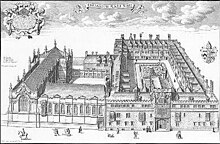
The University of Oxford has 36 colleges, three societies, and four permanent private halls (PPHs) of religious foundation.[1] The colleges and PPHs are autonomous self-governing corporations within the university. These colleges are not only houses of residence, but have substantial responsibility for teaching undergraduate students. Generally tutorials (one of the main methods of teaching in Oxford) and classes are the responsibility of colleges, while lectures, examinations, laboratories, and the central library are run by the university. Students normally have most of their tutorials in their own college, but often have a couple of modules taught at other colleges or even at faculties and departments. Most colleges take both graduates and undergraduates, but several are for graduates only.
Undergraduate and graduate students may name preferred colleges in their applications. For undergraduate students, an increasing number of departments practise reallocation to ensure that the ratios between potential students and subject places available at each college are as uniform as possible. For the Department of Physics, reallocation is done on a random basis after a shortlist of candidates is drawn upon and before candidates are invited for interviews at the university.[2]
For graduate students, many colleges express a preference for candidates who plan to undertake research in an area of interest of one of its fellows. St Hugh's College, for example, states that it accepts graduate students in most subjects, principally those in the fields of interest of the fellows of the college.[3]
A typical college consists of a hall for dining, a chapel, a library, a college bar, senior, middle (postgraduate), and junior common rooms, rooms for 200–400 undergraduates, and lodgings for the head of the college and other dons. College buildings range from medieval to modern, but most are made up of interlinked quadrangles or courtyards, with a porter's lodge controlling entry from the outside.
The first modern merger of colleges was in 2008, with Green College and Templeton College merging to form Green Templeton College.[4] The number of PPHs also reduced when Greyfriars closed in 2008[5] and when St Benet's Hall closed in 2022.[6] Reuben College, established in 2019,[7][8] is the first new Oxbridge college since 1990, when Kellogg College was established.[9]

- ^ "Organisation | University of Oxford". www.ox.ac.uk. Archived from the original on 28 January 2016. Retrieved 14 June 2024.
- ^ "Admissions procedures for Physics courses". The University of Oxford Department of Physics. Archived from the original on 10 May 2021. Retrieved 11 June 2016.
- ^ "Graduate study at St Hugh's". St Hugh's College, University of Oxford. Archived from the original on 2 June 2016. Retrieved 11 June 2016.
- ^ "The merger". Green Templeton College, University of Oxford. Archived from the original on 24 July 2016. Retrieved 11 June 2016.
- ^ "Closure of Greyfriars: University Statement" (Press release). University of Oxford. 25 October 2007. Archived from the original on 29 October 2013. Retrieved 11 June 2016.
- ^ Kenny, Samuel (28 September 2022). "St Hilda's buys St Benet's Hall's buildings". Oxford Student. Archived from the original on 7 November 2022. Retrieved 7 November 2022.
- ^ University of Oxford (11 June 2020). "Reuben Foundation donates £80 million for first new Oxford college in 30 years". Archived from the original on 1 July 2020. Retrieved 1 July 2020.
- ^ "Oxford University Statutes & Regulations, Statute V: Colleges, Societies, and Permanent Private Halls". University of Oxford. Archived from the original on 15 June 2019. Retrieved 7 May 2019.
- ^ "New college planned for Oxford University". 20 August 2018. Archived from the original on 29 April 2019. Retrieved 28 November 2019.